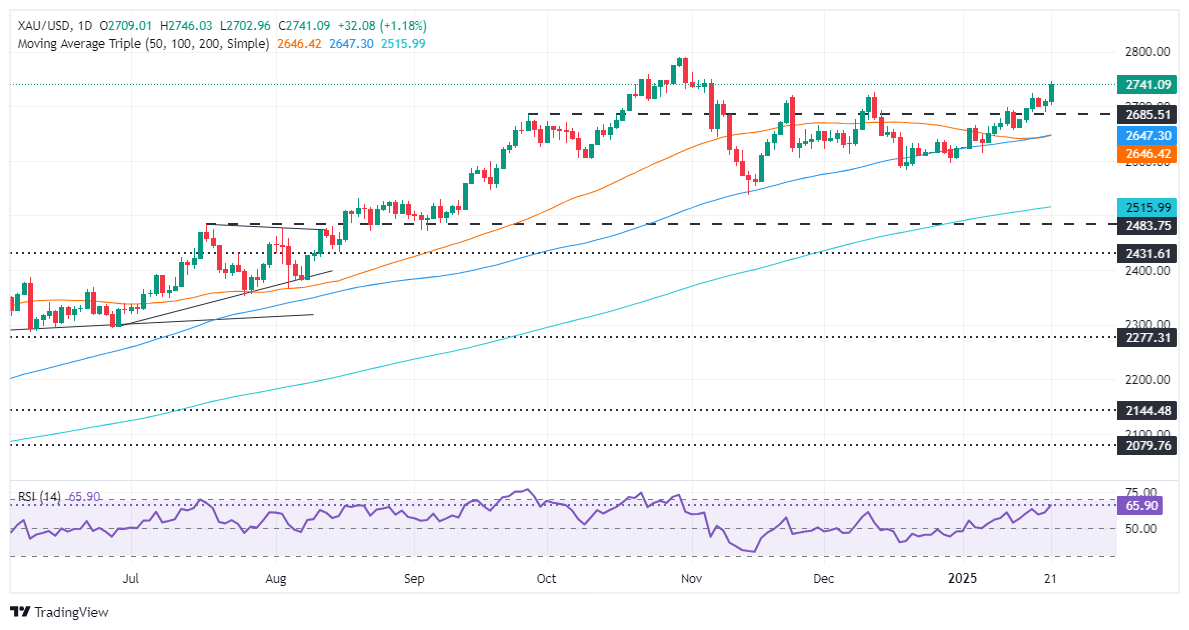- Gold spikes as investors seek safety after Trump’s day-one tariff threats.
- US Dollar Index drops, Treasury yields fall, both tailwinds for Bullion prices.
- Escalating Middle East tensions increases global uncertainty, boosting Gold’s safe-haven status.
Gold rallied more than 1% and hit a two-month high of $2,745 on Tuesday as investors seeking safety bought the non-yielding metal following US President Donald Trump’s remarks on tariffs. The Greenback, which initially advanced, has turned negative as depicted by the US Dollar Index (DXY), a tailwind for Bullion prices. The XAU/USD trades at $2,742 at the time of writing.
Trump’s first day in office improved risk appetite, only to suddenly turn risk-averse after he hinted at imposing tariffs on Canada and Mexico as he signed a tranche of executive orders. The Canadian Dollar (CAD) and the Mexican Peso (MXN) tumbled, consequently sending the Greenback to a daily high of 108.79, according to the DXY.
Despite this, the precious metal continued to trend higher, clearing key resistance at $2,730. In addition, US Treasury bond yields are dropping in the belly and long end of the curve, bolstering Gold prices. The US 10-year T-note yield tumbled five-and-a-half basis points (bps) to 4.572%.
In the Middle East, the ceasefire agreement between Israel and Hamas was set aside as Israeli forces began an operation in the West Bank city of Jenin. In response, Hamas called for escalating the fighting against Israel.
This week, the US economic docket will feature Initial Jobless Claims data, S&P Global Flash PMIs, and housing data.
Daily digest market movers: Gold price soars as US yields retreat
- Gold price rises as real yields tumbled three basis points. Measured by the 10-year Treasury Inflation-Protected Securities (TIPS) yield sits at 2.17%.
- President Trump confirmed that universal tariffs on all imports to the US are under consideration as well and will come at a later stage, Reuters reports.
- Market participants are pricing in near-even odds that the Fed will cut rates twice by the end of 2025, with the first reduction occurring in June.
XAU/USD technical outlook: Gold price breaks higher toward $2,750
The uptrend in Gold prices resumed after bulls had failed to clear the December 12 daily peak of $2,725. This opened the door for challenging the psychological $2,750 figure, and the record high at $2,790 ahead of $2,800.
Conversely, if sellers drive XAU/USD below $2,700, the first support would be the January 13 swing low of $2,656, followed by the confluence of the 50 and 100-day Simple Moving Averages (SMAs) at $2,642 to $2,644.
Risk sentiment FAQs
In the world of financial jargon the two widely used terms “risk-on” and “risk off” refer to the level of risk that investors are willing to stomach during the period referenced. In a “risk-on” market, investors are optimistic about the future and more willing to buy risky assets. In a “risk-off” market investors start to ‘play it safe’ because they are worried about the future, and therefore buy less risky assets that are more certain of bringing a return, even if it is relatively modest.
Typically, during periods of “risk-on”, stock markets will rise, most commodities – except Gold – will also gain in value, since they benefit from a positive growth outlook. The currencies of nations that are heavy commodity exporters strengthen because of increased demand, and Cryptocurrencies rise. In a “risk-off” market, Bonds go up – especially major government Bonds – Gold shines, and safe-haven currencies such as the Japanese Yen, Swiss Franc and US Dollar all benefit.
The Australian Dollar (AUD), the Canadian Dollar (CAD), the New Zealand Dollar (NZD) and minor FX like the Ruble (RUB) and the South African Rand (ZAR), all tend to rise in markets that are “risk-on”. This is because the economies of these currencies are heavily reliant on commodity exports for growth, and commodities tend to rise in price during risk-on periods. This is because investors foresee greater demand for raw materials in the future due to heightened economic activity.
The major currencies that tend to rise during periods of “risk-off” are the US Dollar (USD), the Japanese Yen (JPY) and the Swiss Franc (CHF). The US Dollar, because it is the world’s reserve currency, and because in times of crisis investors buy US government debt, which is seen as safe because the largest economy in the world is unlikely to default. The Yen, from increased demand for Japanese government bonds, because a high proportion are held by domestic investors who are unlikely to dump them – even in a crisis. The Swiss Franc, because strict Swiss banking laws offer investors enhanced capital protection.


